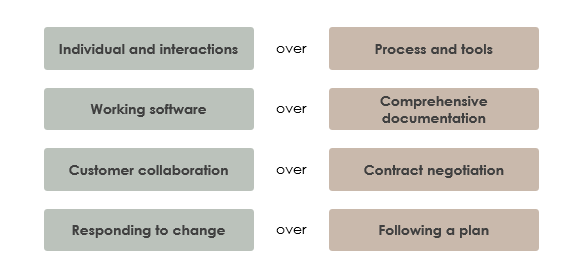Agile Manifesto
History of the Agile Manifesto -
In the late 1990s, traditional software development methods like the Waterfall model were struggling to keep up with rapidly changing project requirements. Recognizing this challenge, a group of 17 software developers, including Kent Beck, Martin Fowler, and Alistair Cockburn, convened in Snowbird, Utah, in 2001.
Purpose of the Agile Manifesto?
The primary goal of the Agile Manifesto is to provide a framework for developing software that can adapt to changing requirements and deliver value to customers efficiently. It shifts the focus from rigid processes and extensive documentation to individuals and interactions, working software, and customer collaboration.
What is Agile Manifesto?
The Agile Manifesto consists of fundamental principles for agile software development, focusing on flexibility, collaboration, and customer satisfaction. It outlines four core values and twelve principles that guide agile practices.
Why is the Agile Manifesto Important?
The Agile Manifesto is important because:
- It shifts the mindset from rigid processes to collaboration and flexibility.
- It helps teams deliver faster and adapt to change.
- It creates better customer relationships through regular feedback.
- It lays the foundation for popular Agile frameworks like Scrum, Kanban, and XP.
The 4 Core Values of the Agile Manifesto

- Individuals and Interactions over Processes and Tools - This value emphasizes the importance of people and their interactions in the development process. While tools and processes are essential, effective communication and collaboration among team members are paramount. For instance, a team that communicates openly can adapt more quickly to changes than one strictly following rigid processes.
- Working Software over Comprehensive Documentation - Delivering functional software is prioritized over producing extensive documentation. While documentation has its place, the primary goal is to develop software that meets users' needs. For example, a prototype that users can interact with provides more value than a detailed specification document.
- Customer Collaboration over Contract Negotiation - Engaging customers throughout the development process ensures the product aligns with their expectations. Instead of sticking strictly to contract terms, Agile encourages ongoing collaboration to accommodate evolving requirements. For instance, regular feedback sessions with clients can lead to a product that better serves their needs.
- Responding to Change over Following a Plan - Agile values adaptability. While planning is essential, being flexible and responsive to change is more valuable. For example, if market conditions shift, an Agile team can pivot their approach to meet new demands effectively.
The 12 Principles of the Agile Manifesto
- Customer Satisfaction: Delivering valuable software early and continuously.
- Embracing Change: Welcoming changing requirements, even late in development.
- Frequent Delivery: Delivering working software frequently, with a preference for shorter timescales.
- Collaboration: Business people and developers working together daily throughout the project.
- Motivated Individuals: Building projects around motivated individuals and giving them the environment and support they need.
- Face-to-Face Conversation: The most efficient and effective method of conveying information.
- Working Software: The primary measure of progress.
- Sustainable Development: Promoting sustainable development by maintaining a constant pace.
- Technical Excellence: Continuous attention to technical excellence and good design.
- Simplicity: Maximizing the amount of work not done.
- Self-Organizing Teams: The best architectures, requirements, and designs emerge from self-organizing teams.
- Reflection and Adjustment: At regular intervals, the team reflects on how to become more effective and adjusts accordingly.
How to Use the Agile Manifesto?
Using the Agile Manifesto means applying its values and principles in everyday team work.
- Start small – Begin by holding daily standups or writing user stories.
- Focus on working software – Don’t spend months planning; start building.
- Collaborate – Involve the customer often; listen to their feedback.
- Embrace change – Be ready to shift direction when needed.
- Reflect and improve – After every sprint, discuss what went well and what can be better.
